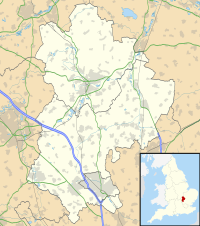Podington Castle facts for kids
Quick facts for kids Podington Castle |
|
|---|---|
| Podington, Bedfordshire, England | |
| Coordinates | 52°15′22″N 0°37′12″W / 52.2562°N 0.6199°W |
| Type | Castle |
| Site information | |
| Condition | Earthworks |
Podington Castle, also known as Puddington Manor Farm, was a castle built in the 11th century. It was located in the village of Podington in the county of Bedfordshire, England.
Contents
What Was Podington Castle?
Podington Castle was a special type of castle called a "motte-and-bailey." This design was very popular in England after the Norman Conquest.
Understanding Motte-and-Bailey Castles
A "motte" is a large earth mound, like a small hill. On top of this mound, a wooden or stone tower was built. The "bailey" was a fenced-in area at the bottom of the mound. It was often surrounded by a ditch or a moat filled with water.
Podington Castle had one main mound (motte) and three separate bailey areas. This made it a very strong and protected place.
Early Records of the Castle
The castle is mentioned in the Domesday Book of 1086. This was a huge survey ordered by William the Conqueror to record all the land and property in England. The Domesday Book shows that Hugh the Fleming owned Podington Castle at that time.
The Castle's Later Years
Podington Castle did not last forever. By the early 1600s, it was already in ruins. This means it was falling apart and no longer used as a castle.
The New Podington Manor
A new house, called Podington Manor, was built close to where the old castle stood. This new house is now known as "Old Podington Manor."
In 1694, the owners of Podington Manor moved to a different home. After they left, the manor house became a farmhouse.
What Remains Today?
Even though the castle is long gone, you can still see parts of it today. The large earthworks, which are the remains of the castle's mounds and ditches, can be found. They are in a field behind Old Podington Manor.
As recently as 1972, you could still see the foundations of the old castle buildings. These are the parts of the walls that were underground.


